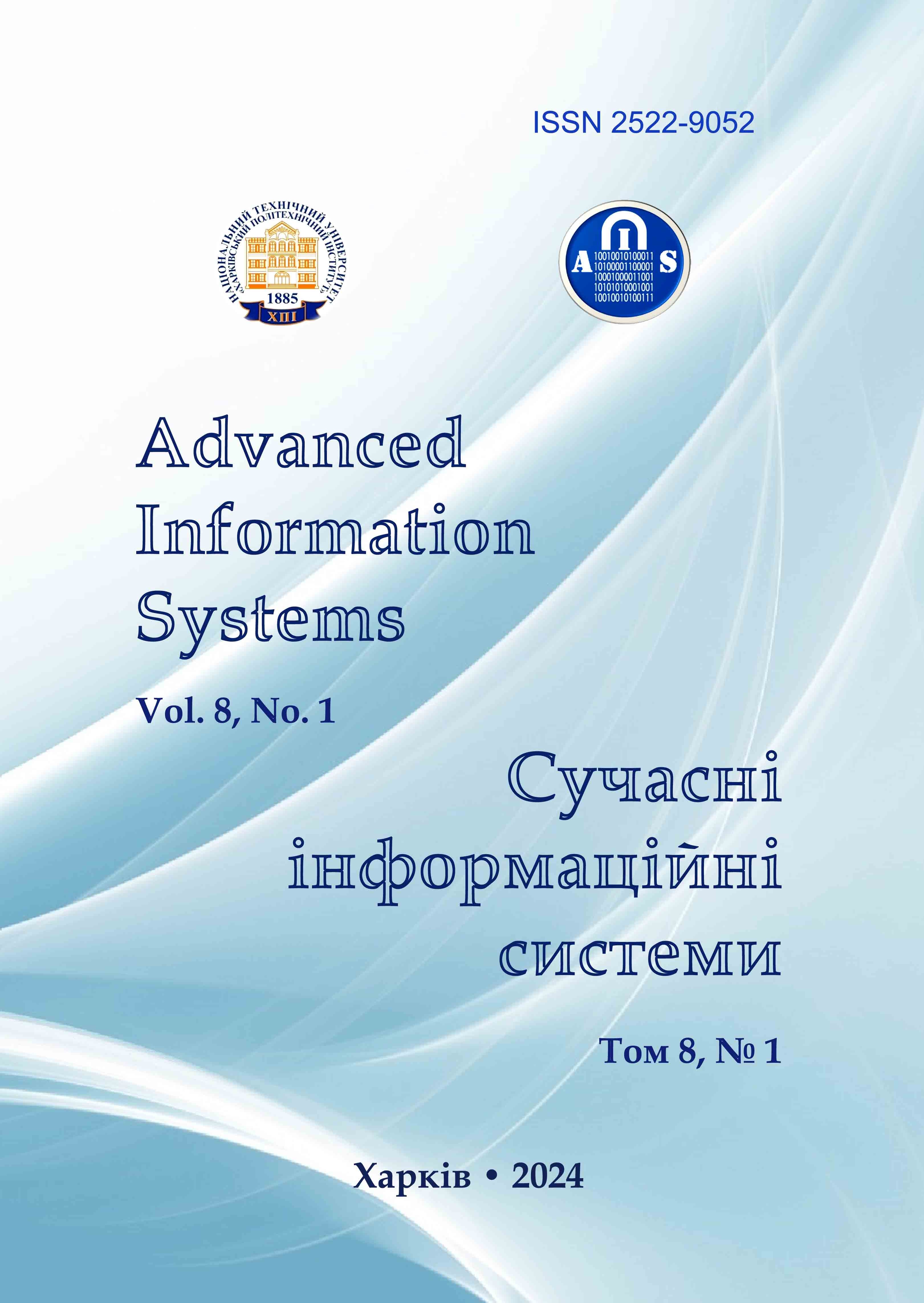INTRUSION DETECTION MODEL BASED ON IMPROVED TRANSFORMER
Main Article Content
Abstract
The object of the study is the process of identifying the state of a computer network. The subject of the study are the methods of identifying the state of computer networks. The purpose of the paper is to improve the efficacy of intrusion detection in computer networks by developing a method based on transformer models. The results obtained. The work analyzes traditional machine learning algorithms, deep learning methods and considers the advantages of using transformer models. A method for detecting intrusions in computer networks is proposed. This method differs from known approaches by utilizing the Vision Transformer for Small-size Datasets (ViTSD) deep learning algorithm. The method incorporates procedures to reduce the correlation of input data and transform data into a specific format required for model operations. The developed methods are implemented using Python and the GOOGLE COLAB cloud service with Jupyter Notebook. Conclusions. Experiments confirmed the efficiency of the proposed method. The use of the developed method based on the ViTSD algorithm and the data preprocessing procedure increases the model's accuracy to 98.7%. This makes it possible to recommend it for practical use, in order to improve the accuracy of identifying the state of a computer system.
Article Details
References
Gavrylenko, S., Chelak, V. and Hornostal, O. (2020), “Research of Intelligent Data Analysis Methods for Identification of Computer System State”, Proceedings of the 30th International Scientific Symposium Metrology and Metrology Assurance (MMA), Sozopol, Bulgaria, pp. 1–5, doi: https://doi.org/10.1109/MMA49863.2020.9254252
Semenov, S., Mozhaiev, O., Kuchuk, N., Mozhaiev, M., Tiulieniev, S., Gnusov, Y., Yevstrat, D., Chyrva, Y. and Kuchuk, H. (2022), “Devising a procedure for defining the general criteria of abnormal behavior of a computer system based on the improved criterion of uniformity of input data samples”, Eastern-European Journal of Enterprise Technologies, vol. 6(4), pp. 40-49, doi: https://doi.org/10.15587/1729-4061.2022.269128
Bhupendra I., Anamika Y. and Atul, S. (2017), “Decision Tree Based Intrusion Detection System for NSL-KDD Dataset, Conference: International Conference on Information and Communication Technology for Intelligent Systems (ICTIS 2017), doi: https://doi.org/10.1007/978-3-319-63645-0_23
Zhang, J., Zulkernine, M. and Haque, A. (2008), “Random-Forests-Based Network Intrusion Detection Systems”, IEEE Transactions on Systems, Man, and Cybernetics, Part C (Applications and Reviews), vol. 38, no. 5, pp. 649–659, doi: https://doi.org/10.1109/TSMCC.2008.923876
Liao, Y. and Vemuri, R. (2002), “Use of K-Nearest Neighbor classifier for intrusion detection”, Computers and Security, Volume 21, Issue 5, pp. 439–448, doi: https://doi.org/10.1016/S0167-4048(02)00514-X
Meleshko, Ye., Drieiev, O., Yakymenko, M. and Lysytsia, D. (2020), “Developing a model of the dynamics of states of a recommendation system under conditions of profile injection attacks”, Eastern-European Journal of Enterprise Technologies, vol. 4, no 4(106), pp. 14–24,. doi: https://doi.org/10.15587/1729-4061.2020.209047
Yaloveha, V., Podorozhniak, A. and Kuchuk, H. (2022), “Convolutional neural network hyperparameter optimization applied to land cover classification”, Radioelectronic and Computer Systems, vol. 1(2022), pp. 115–128, doi: https://doi.org/10.32620/REKS.2022.1.09
Gavrylenko, S. and Hornostal, O. (2023), “Application of heterogeneous ensembles in problems of computer system state identification”, Advanced Information System, vol. 7, no. 4, рр. 5–12, doi: https://doi.org/10.20998/2522-9052.2023.4.01
Wei, W. (2017), “Malware Traffic Classification Using Convolutional Neural Network for Representation Learning”, Recent Advances in Machine Learning and Applications, doi: https://doi.org/10.1109/ICOIN.2017.7899588
Ashfaq, M. (2021), “HCRNNIDS: Hybrid Convolutional Recurrent Neural Network-Based Network Intrusion Detection System. Processes”, doi: https://doi.org/10.3390/pr9050834
Laghrissi, F., Douzi, S. and Douzi, K. (2021), ”Intrusion detection systems using long short-term memory (LSTM)”, J Big Data, vol. 8(65), doi: https://doi.org/10.3390/pr9050834
Sak, H., Senior, A. and Beaufays, F. (2014), “Long Short-Term Memory Recurrent Neural Network Architectures for Large Scale Acoustic Modeling”, Interspeech, pp. 338–342, doi: https://doi.org/10.21437/Interspeech.2014-80
Khan, T., Alhussein, M., Aurangzeb, V., Arsalan, K., Naqvi, S. and Nawaz, S. (2020), “Residual Connection-Based Encoder Decoder Network (RCED-Net) for Retinal Vessel Segmentation”, IEEE Access, vol. 8, pp. 131257–131272, doi: https://doi.org/10.1109/ACCESS.2020.3008899
Ba, J., Kiros, J. and Hinton, G. (2016), “Layer Normalization”, arXiv, doi: https://doi.org/10.48550/arXiv.1607.06450
Dosovitskiy A., Beyer L., Kolesnikov A., Weissenborn D., Zhai X., Unterthiner T., Mostafa Dehghani, Minderer M., Heigold G., Sylvain Gelly, Uszkoreit, J. and Houlsby, N. (2021), “An Image is Worth 16x16 Words: Transformers for Image Recognition at Scale”, Conference paper at ICLR, arXiv, arXiv:2010.11929, doi: https://doi.org/10.48550/arXiv.2010.11929
Seung, L., Seunghyun, L. and Byung, S. (2021), “Vision Transformer for Small-Size Datasets”, arXiv, arXiv:2112.13492v1 [cs.CV], 27 Dec 2021, doi: https://doi.org/10.48550/arXiv.2112.13492
Gavrylenko, S. and Poltoratskiy, V. (2023), “Method of increasing the efficiency of data classification at the account of reducing the correlation of the sign”, Control, Navigation and Communication Systems, No. 4 (74), pp. 71–75, doi: https://doi.org/10.26906/SUNZ.2023.4.070
